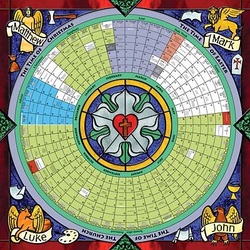We learned from our teachers in grade school that there is no such thing as a bad question. While this may be true, it is also true that some questions serve a greater purpose than others. By asking ourselves, during the season of Advent, why God would care enough about us mortals to take our flesh and share our woes, two important purposes are being served.
First, the connection between the manger and cross are brought into closer companionship. Luther would often say that the manger and the cross are made of the same wood. That is to say that they are both made by wood stained with the blood of the sin and disobedience of God’s creatures. They are also stained with the sweat and tears of our personal God who cares about his entire creation. His care is shown in his action to send his Son, Jesus and close the gap of distance and separation between him and creatures that have forgotten to hear, listen, and obey the good and holy Word of their heavenly Father.
The second purpose that is served by asking the question, “Why would the Lord of all the universe care enough about us mortals to take our flesh and share our woes?” is that it leads us to consider all the ways in which our God comes to us. Since the season of Advent occurs during the four weeks prior to Christmas Day, it can be easy for us to focus our eyes only on the baby Jesus cradled in the manger. But if we pull back the curtains a little farther we can bring into view all the ways that God comes to us.
Our God splits the heavens and comes down not just during the event that we celebrate one month from now on Christmas morning. The purpose of the season of Advent is not so that the church can transport itself back two thousand years ago and pretend to be first century Jews who are waiting for their Messiah to be born. We live in the twenty-first century. So let us believe more firmly the truth that God has already come to us, is continuing to come to us, and will come back to us.
We certainly take time within our congregation and within our families to celebrate God’s coming to us on Christmas morning. However, at the same time we embrace the fact that our God who is beyond time and space comes down to us in time and space every Sunday morning to deliver the fruit of his Son’s crucifixion and resurrection over two thousand years ago through his Word and Sacraments. He comes to us through his instruments: the water and the Word of God, the bread and the wine, the mouth of the pastor who forgives our sins, and the Bible which contains all of God’s promises in Christ. In these ways we receive, Immanuel, “God with us,” now! As we live in a world where the evidence of the sin, suffering, and brokenness of creation is all too evident, we receive God’s peace on earth as he comes to us “hidden” in the Word and Sacraments. We also embrace his promise of Christ to restore his broken creation and to completely “reveal” his victory over suffering and death in his coming again to us in glory, just as he said.
The truth that God cares enough for us mortals to take on our flesh and share our woes is shown to us in the wonderful Christmas story which we eagerly wait to celebrate. But take comfort now in this truth as it is made known to you now through God’s Word and his Sacraments. As members of his church we should equip ourselves to share this good news with others who live among us and are confused in their questioning, suffering, and despair. And as you equip yourselves this Advent season and share the reason for the hope that you have in Christ, rest assured that he is coming again soon.
In Christ,
Pastor Josh

 RSS Feed
RSS Feed